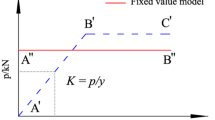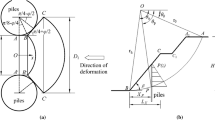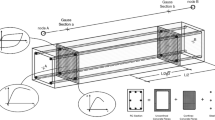Abstract
This study focuses on the seismic performance assessment of slopes reinforced with pile anchor structures. Pile anchors are a common and effective method for stabilizing slopes, especially in areas with weak or unstable soil. However, the dynamic behaviour of pile anchor structures in slope reinforcement is yet to be explored. To address this gap, the study presents a fragility analysis approach based on incremental dynamic analysis to evaluate the factors of safety and permanent displacement of pile anchor structures under seismic loading. The performance-based earthquake engineering analysis involves conducting a series of dynamic time history analyses using multiple seismic records of varying scales. By considering different vulnerability states, fragility functions are developed to assess the performance of pile anchor structures in terms of factors of safety and permanent displacement. The analysis incorporates various factors such as soil strength, stiffness, slope geometry, anchor structure characteristics, and dynamic forces during earthquakes. The obtained fragility functions provide valuable information regarding the failure probabilities of pile anchor structures under different vulnerability states, thereby aiding in the design and evaluation of slope reinforcement measures for enhanced seismic resilience.

















Similar content being viewed by others
References
Huang Y, Zhao L, Xiong M, Liu C, Lu P (2018) Critical slip surface and landslide volume of a soil slope under random earthquake ground motions. Environ Earth Sci 77(23):1–11. https://doi.org/10.1007/s12665-018-7974-5
Wu XZ (2015) Development of fragility functions for slope instability analysis: fragility functions for slope instability analysis. Landslides 12(1):165–175. https://doi.org/10.1007/s10346-014-0536-3
Duncan JM (2015) Factors of safety and reliability in geotechnical engineering. J Geotech Geoenviron Eng 20(6):14–15. https://doi.org/10.1016/j.jmpt.2011.05.010
Griffiths DV, Lane PA (1999) Slope stability analysis by finite elements. Geotechnique 49(3):387–403. https://doi.org/10.1680/geot.1999.49.3.387
Lagaros ND, Tsompanakis Y, Psarropoulos PN, Georgopoulos EC (2009) Computationally efficient seismic fragility analysis of geostructures. Comput Struct 87(19–20):1195–1203. https://doi.org/10.1016/j.compstruc.2008.12.001
Argyroudis S, Kaynia AM, Pitilakis K (2013) Development of fragility functions for geotechnical constructions: application to cantilever retaining walls. Soil Dyn Earthq Eng 50:106–116. https://doi.org/10.1016/j.soildyn.2013.02.014
Uzielli M, Nadim F, Lacasse S, Kaynia AM (2008) A conceptual framework for quantitative estimation of physical vulnerability to landslides. Eng Geol 102(3–4):251–256. https://doi.org/10.1016/j.enggeo.2008.03.011
Vamvatsikos D, Allin Cornell C (2002) Incremental dynamic analysis. Earthq Eng Struct Dyn 31(3):491–514. https://doi.org/10.1002/eqe.141
Baker JW (2015) Efficient analytical fragility function fitting using dynamic structural analysis. Earthq Spectra 31(1):579–599. https://doi.org/10.1193/021113EQS025M
Argyroudis SA, Pitilakis KD (2012) Seismic fragility curves of shallow tunnels in alluvial deposits. Soil Dyn Earthq Eng 35:1–12. https://doi.org/10.1016/j.soildyn.2011.11.004
Kassem MM, Mohamed Nazri F, NoroozinejadFarsangi E (2020) The seismic vulnerability assessment methodologies: a state-of-the-art review. Ain Shams Eng J 11(4):849–864. https://doi.org/10.1016/j.asej.2020.04.001
Calabrese A, Lai CG (2016) Sensitivity analysis of the seismic response of gravity quay walls to perturbations of input parameters. Soil Dyn Earthq Eng 82:55–62. https://doi.org/10.1016/j.soildyn.2015.11.010
Hu H, Huang Y, Chen Z (2019) Seismic fragility functions for slope stability analysis with multiple vulnerability states. Environ Earth Sci. https://doi.org/10.1007/s12665-019-8696-z
Pan J, Xu Y, Jin F (2015) Seismic performance assessment of arch dams using incremental nonlinear dynamic analysis. Eur J Environ Civ Eng 19(3):305–326. https://doi.org/10.1080/19648189.2014.960950
Huang Y, Xu X, Mao W (2019) Numerical performance assessment of slope reinforcement using a pile-anchor structure under seismic loading. Soil Dyn Earthq Eng. https://doi.org/10.1016/j.soildyn.2019.105963
GEO-SLOPE (2013) Stress-deformation modeling with SIGMA/W an engineering methodology, no September, p 223.
GEO-SLOPE (2013) International Ltd. Dynamic modeling with QUAKEW, p 171
GEO-SLOPE (2013) International Ltd. Stability modeling with SLOPEW, p 282
Porter K, Kennedy R, Bachman R (2007) Creating fragility functions for performance-based earthquake engineering. Earthq Spectra 23(2):471–489. https://doi.org/10.1193/1.2720892
Serdar Kirçil M, Polat Z (2006) Fragility analysis of mid-rise R/C frame buildings. Eng Struct 28(9):1335–1345. https://doi.org/10.1016/j.engstruct.2006.01.004
Jibson RW, Michael JA (2009) Maps showing seismic landslide hazards in Anchorage, Alaska. USGS Sci Investig Map 3077:1–11
IS-1893-Part-1 (2016) Criteria for earthquake resistant design of structures. Bureau of Indian Standards, New Delhi
Deoda VR, Adhikary S (2020) A preliminary proposal towards the revision of Indian seismic code considering site classification scheme, amplification factors and response spectra. Bull Earthq Eng 18(6):2843–2889. https://doi.org/10.1007/s10518-020-00806-2
Alembagheri M, Ghaemian M (2013) Damage assessment of a concrete arch dam through nonlinear incremental dynamic analysis. Soil Dyn Earthq Eng 44:127–137. https://doi.org/10.1016/j.soildyn.2012.09.010
Heidary-Torkamani H, Bargi K, Amirabadi R (2014) Seismic vulnerability assessment of pile-supported wharves using fragility curves. Struct Infrastruct Eng 10(11):1417–1431. https://doi.org/10.1080/15732479.2013.823453
IS14243-2 (1995) Guidelines for selection and development of site for building in hill areas, Part 2: Selection and development. Bur. Indian Stand. N.Delhi, India
Technical code for Seismic design of Buildings (2010) Ministry of Housing and Urban–Rural construction of Peoples Republic of China, p GB50011
EN 1998-5 (2004) (English) Eurocode 8: Design of structures for earthquake resistance Part 5: Foundations, retaining structures and geotechnical aspects Eurocode, vol 1, no 2005. 2011
Kramer SL, Paulsen SB (2004) Seismic performance evaluation of reinforced slopes. Geosynth Int 11(6):429–438. https://doi.org/10.1680/gein.2004.11.6.429
Funding
The financial assistance provided by the Science and Engineering Research Board (SERB) a statutory body of the Department of Science and Technology (DST), Government of India, under the SERB – POWER Research Grants Award No. SPG/2021/003400 is highly acknowledged. The authors would like to thank the three anonymous reviewers for their valuable and constructive comments to improve the manuscript.
Author information
Authors and Affiliations
Corresponding author
Ethics declarations
Conflict of interest
The authors declare that they have no conflict of interest.
Additional information
Publisher's Note
Springer Nature remains neutral with regard to jurisdictional claims in published maps and institutional affiliations.
Rights and permissions
Springer Nature or its licensor (e.g. a society or other partner) holds exclusive rights to this article under a publishing agreement with the author(s) or other rightsholder(s); author self-archiving of the accepted manuscript version of this article is solely governed by the terms of such publishing agreement and applicable law.
About this article
Cite this article
Rahangdale, D., Singh, A. & Adhikary, S. Seismic Fragility Analysis of Finite Slope Considering Pile–Anchor Structure. Indian Geotech J (2024). https://doi.org/10.1007/s40098-024-00954-1
Received:
Accepted:
Published:
DOI: https://doi.org/10.1007/s40098-024-00954-1




